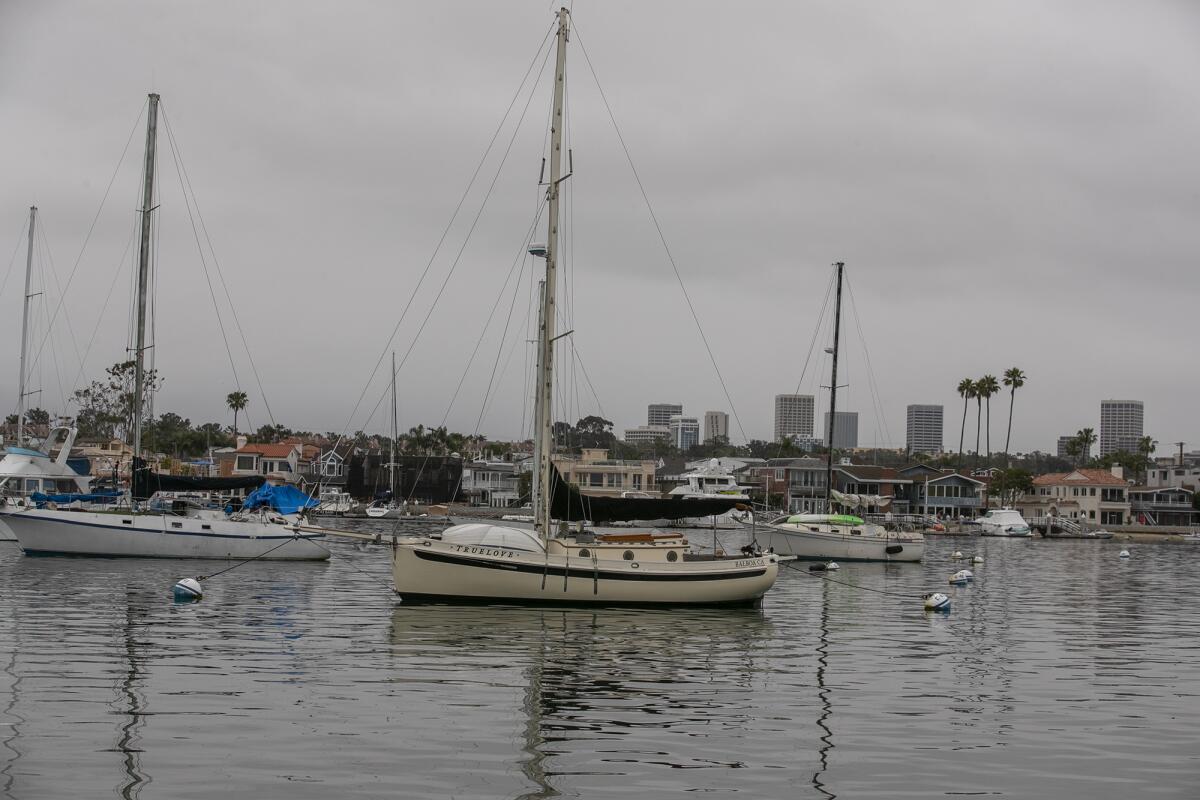Pilot program for mooring changes to go to state Coastal Commission

- Share via
Changes to Newport Beach’s existing mooring fields may soon be on their way, depending on the results of a pilot program that the city’s engineering and design teams are readying for Coastal Commission approval.
Newport Harbor is one of the largest small-craft recreational harbors on the West Coast, and is home to roughly 1,200 moorings — all of which the city of Newport Beach has overseen since 2017. Of those 1,200 moorings, about 800 are offshore moorings in 10 different mooring fields. Boaters using them are required to apply for permits and the Harbor Department reported receiving requests to extend the permitted length of several offshore moorings.
But upon inspection, city staff found there were no effective or objective means to do so, which then led to what was described in a staff report presented to the City Council as a “disorganized arrangement of moorings of various sizes throughout the mooring fields.”
A subcommittee of the Harbor Commission was formed in 2018 and focused on improvement of the existing mooring fields, the permitting process and safe navigation for all of the harbor’s users. Recommendations were made and several meetings were held with commercial operators, homeowners’ associations and yacht clubs.
What was proposed to the council Tuesday night was the launching of a pilot project in the offshore Mooring Field C, located just off of the Fernando Street public pier.
The project would reconfigure the mooring field to double-row moorings, placing boats closer together, taking up less space while offering the same number of potential moorings. Boats of like sizes would be consolidated into the same rows. Harbor Commission Vice Chair Ira Beer referenced America’s Cup Harbor in San Diego, which utilizes double-row moorings, as an example of the practice.

Roughly 180 moorings are available in the San Diego harbor, but it spans only 15 acres. Newport Harbor, by comparison, has about 200 moorings available in 30 acres.
Only one to two rows of Mooring Field C will be reconfigured as part of the pilot program at first, then expanded to the rest of the field over the course of 30 days after its approval.
In its approvals of the pilot program, council members gave the city staff the ability to apply for a permit with the state Coastal Commission to reconfigure the fields. Any implementation of the plan will be contingent on whether or not the commission approves the permit.
Other code amendments focused on clarification of mooring requirements, maintaining a permit and defined new mooring permits for any new such public fields as nontransferable to allow greater access to public tidelands. Existing permits would not be affected.
While a number of supporters attended the meeting to lend their support, including former Councilman Marshall “Duffy” Duffield, the majority of public commentators disapproved of the pilot project. Several speakers raised concerns about the safety of double-row mooring because of the close proximity and the potential difficulties with navigation if the project went forward. Some pointed out that there are differences in winds and currents between those found in Newport Beach and those that exist in the America’s Cup Harbor.
Councilman Brad Avery said he understood the concerns that people had but that he could foresee the double-rows working.
“Each captain’s got to judge his or her ability to get on the mooring and your crew and the current,” said Avery, an experienced sailor. “I never leave or come back without knowing which way the current’s going and try to solve for zero current on a timing schedule, but I know that’s not always the case [with other captains].”
Avery noted the contention of the issue, particularly between the Newport Mooring Assn., permit holders and the Harbor Commission.
“We need to have the trial. We need to hold it and we need people to give it a good shot because I think this is, on balance, a good plan, but I’m ready to change,” Avery said. “Nobody wants people to have a tough time getting on their mooring, tougher than it is now, but we have to do the trial, and I hope everybody, if this goes through, those that participate in it do it objectively and experiment.”
All the latest on Orange County from Orange County.
Get our free TimesOC newsletter.
You may occasionally receive promotional content from the Daily Pilot.




